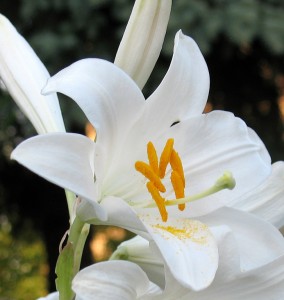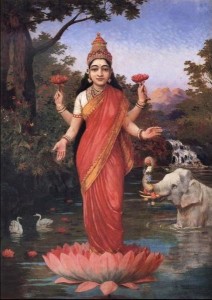


Tag: Kwan Yin
The Hand of Kwan Yin
May 31, 2013 This is the statue of the goddess Kwan Yin which I have on my altar. It was given to me by a student after my first Kwan Yin statue was broken by my cat – not Samhain, the cat I had before her, Misha.I was very grieved by the loss of this statue, not only because Kwan Yin is an important goddess to me, but because the statue was given to me by a good friend I had lost touch with. Someone explained to me, however, that porcelain statues of Kwan Yin are expected to break eventually, and that I should take the statue to a temple rather than dispose of it myself.Knowing how devastated I was by these events, one of my students was excited to find a statue she thought was Kwan Yin at a garage sale. “I don’t know if this is Kwan Yin but I thought it might be,” she said. “But there’s a hole in it where one of the hands should be. We’ve been trying to figure out what that’s for.” I knew exactly what the hole was for, because my first statue had the same feature. The hole is for a detachable hand that is removed from the statue when making a request. The supplicant carries the hand around with her until the prayer is granted, then returns it to the goddess.Kwan Yin is the Chinese Buddhist goddess of mercy, “She who hears the cries of the world.” She is a complex and multifaceted goddess who has been the subject of much scholarship, particularly with the rebirth of the Goddess Movement. Even before this she had a sizable devoted following, among Westerners as well as Chinese. I first heard about Kwan Yin at a lecture given by the editor of a paper I worked on, Libby Gregory. In the dark ages before videos and the Internet, Midwesterners went to lectures for entertainment. I don’t know if it was a product of the big tent Christian revival experiences of the audience or if this is a common experience during discussions of Kwan Yin, but after Libby’s talk many people came forward and shared their miraculous experiences with Kwan Yin’s intervention. I was impressed.Because she introduced me to Kwan Yin, my feelings about this goddess are intertwined with my feelings about Libby. A small business owner and editor of the local left-wing paper, Libby was a driving force behind the progressive movement in our conservative town. To be honest I often thought of her as a bit of a nuisance, frequently calling me on the telephone requesting my services for hard journalistic assignments requiring a great deal of investigation. For some reason I almost always said yes, even though these assignments offered very little pay. It was another Kwan Yin miracle.Eventually I moved away to the West Coast and didn’t think too much about Libby. I liked her, but I certainly didn’t give her my new phone number. It was when I was back for one of my infrequent visits that I learned Libby had died several years earlier, killed in a plane crash. Although Libby had never been a huge figure in my personal life, I could not imagine the town without her. She was like the Olentangy River or the state university campus – she was a part of the community structure. Her loss left a hole that could not be replaced.It did not surprise me to learn that “killed in a plane crash” only told part of the story. Libby had stayed behind to help other passengers as the smoking plane was being evacuated, and so was one of the few who did not survive. We could wish she had left the burning aircraft while she had a chance, but if she had done that she wouldn’t have been the person she was.When I was ordained in the Fellowship of Isis, I was asked to make a pledge to three goddesses, one of which I would be “priestess of” and two more I would agree to serve. I chose Kwan Yin as one of my three goddesses. Not because of Libby exactly, but because of mercy.My student took the statue back home and asked her woodworking husband to make a new hand for it. I’ve always wondered about the missing hand, if someone prayed for something they wanted very much and the request was never granted. I hope by this time they have found recompense for their loss.
This is the statue of the goddess Kwan Yin which I have on my altar. It was given to me by a student after my first Kwan Yin statue was broken by my cat – not Samhain, the cat I had before her, Misha.I was very grieved by the loss of this statue, not only because Kwan Yin is an important goddess to me, but because the statue was given to me by a good friend I had lost touch with. Someone explained to me, however, that porcelain statues of Kwan Yin are expected to break eventually, and that I should take the statue to a temple rather than dispose of it myself.Knowing how devastated I was by these events, one of my students was excited to find a statue she thought was Kwan Yin at a garage sale. “I don’t know if this is Kwan Yin but I thought it might be,” she said. “But there’s a hole in it where one of the hands should be. We’ve been trying to figure out what that’s for.” I knew exactly what the hole was for, because my first statue had the same feature. The hole is for a detachable hand that is removed from the statue when making a request. The supplicant carries the hand around with her until the prayer is granted, then returns it to the goddess.Kwan Yin is the Chinese Buddhist goddess of mercy, “She who hears the cries of the world.” She is a complex and multifaceted goddess who has been the subject of much scholarship, particularly with the rebirth of the Goddess Movement. Even before this she had a sizable devoted following, among Westerners as well as Chinese. I first heard about Kwan Yin at a lecture given by the editor of a paper I worked on, Libby Gregory. In the dark ages before videos and the Internet, Midwesterners went to lectures for entertainment. I don’t know if it was a product of the big tent Christian revival experiences of the audience or if this is a common experience during discussions of Kwan Yin, but after Libby’s talk many people came forward and shared their miraculous experiences with Kwan Yin’s intervention. I was impressed.Because she introduced me to Kwan Yin, my feelings about this goddess are intertwined with my feelings about Libby. A small business owner and editor of the local left-wing paper, Libby was a driving force behind the progressive movement in our conservative town. To be honest I often thought of her as a bit of a nuisance, frequently calling me on the telephone requesting my services for hard journalistic assignments requiring a great deal of investigation. For some reason I almost always said yes, even though these assignments offered very little pay. It was another Kwan Yin miracle.Eventually I moved away to the West Coast and didn’t think too much about Libby. I liked her, but I certainly didn’t give her my new phone number. It was when I was back for one of my infrequent visits that I learned Libby had died several years earlier, killed in a plane crash. Although Libby had never been a huge figure in my personal life, I could not imagine the town without her. She was like the Olentangy River or the state university campus – she was a part of the community structure. Her loss left a hole that could not be replaced.It did not surprise me to learn that “killed in a plane crash” only told part of the story. Libby had stayed behind to help other passengers as the smoking plane was being evacuated, and so was one of the few who did not survive. We could wish she had left the burning aircraft while she had a chance, but if she had done that she wouldn’t have been the person she was.When I was ordained in the Fellowship of Isis, I was asked to make a pledge to three goddesses, one of which I would be “priestess of” and two more I would agree to serve. I chose Kwan Yin as one of my three goddesses. Not because of Libby exactly, but because of mercy.My student took the statue back home and asked her woodworking husband to make a new hand for it. I’ve always wondered about the missing hand, if someone prayed for something they wanted very much and the request was never granted. I hope by this time they have found recompense for their loss.
